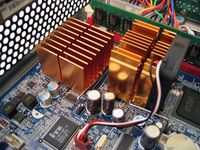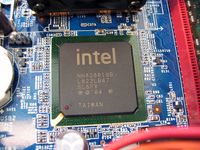Shuttle's X27: Can Atom Handle Vista?
Shuttle’s X2700: Hardware
The X2700 consists of two parts: the X27 platform and all of the optional components added to yield a functional machine. The X27 itself is made up of an enclosure, a 945GC-based motherboard, and an Intel Atom 230 processor built onto the board. Extra features include the hard drive, optical drive, memory module, and wireless networking support.
Processor:
As mentioned, there’s an Intel Atom 230 driving the X27. That’s both good and bad news.
On the plus side, power consumption as low as 4 W means the CPU can easily be kept cool with a passive heatsink. The 45 nm chip includes 64-bit extensions and all of Intel’s multimedia extensions up to SSE3. It also sports Hyper-Threading for better resource utilization in multi-tasked usage scenarios. Although 1.6 GHz doesn’t sound like much, the plucky little processor is able to run Windows Vista, though Shuttle bundles Foresight Linux with the ready-made X2700.
Conversely, as we saw in this story comparing the Atom to AMD’s Athlon 64 2000+, the Intel 945GC chipset that is for some reason paired to the Atom 230 has a TDP of 22.2 W, GMA 950 graphics, no Blu-ray acceleration, and no HDCP support. Thus, the energy-saving story gets a tad diluted. Then there’s the issue of performance. Shuttle clearly knows the 1.6 GHz chip isn’t quite beefy enough for Vista—hence the Linux bundle. But it still advertises X27 as Vista-ready. Indeed, if the X2700 is going to see much play as a desktop workstation, it’d likely see lots of use with XP and Vista added on.
Platform:
Shuttle’s 945GC-based motherboard is small enough to fit within the mini-ITX specification. Despite its form factor, there’s a lot happening on-board.
Get Tom's Hardware's best news and in-depth reviews, straight to your inbox.
One 240-pin DDR2 slot supports up to 2 GB of memory—maxed out on our sample with a 667 MHz module. Factor in a 256 MB loss at the hands of integrated graphics and you’re looking at yet another reason to think hard before adopting Vista.
The 945GC Northbridge features a built-in GMA 950 core, which supports the vertex shader model 3.0 spec and the pixel shader model 2.0 spec to achieve DirectX 9.0c compliance. However, don’t think you’re going to do any gaming on this thing. Despite its four pixel pipelines, meager memory bandwidth and a lackluster fill rate mean you wouldn’t play anything on the X27 even if it had a more muscular CPU.
Fortunately, there is plenty of integration to make the X27 a more complete offering. Between the 945GC Northbridge and dated ICH7 Southbridge, you get the aforementioned graphics, 5.1-channel high definition audio, two channels of SATA, one of PATA, and Gigabit Ethernet via Marvell’s 88E8056 controller.
The platform’s motherboard accommodates more connectivity than the X27 includes. For instance, there are three four-pin fan headers. But there’s only one used by a 20 mm chipset cooler. The parallel ATA connector isn’t put to use at all.
Memory, Hard Drive, And Optical Drive
Just three components separated our X2700 sample from the X27 barebones you can buy for less than $200 online: one memory module, one hard drive, and one optical drive. That hardware trio pushes the price of a completed X2700 up to $429.


The memory in question is a 2 GB Kingston DDR2-667 CAS 5 module which, you might be surprised to learn, sells for just over $30 online. Shuttle sells it as a $30 upgrade to the 1 GB module standard in the X2700. Chalk up one reason to buy the barebones and put your own system together.
The X2700’s hard drive is an 80 GB Toshiba MK8052GSX, a 2.5” SATA drive that spins at 5,400 RPM and is priced just over $40 online. Stepping up to a 120 GB model on Shuttle’s configurator runs a scant $20—well worth the price given the extra 40 GB. Or, pay an extra $385 for a 32 GB SSD (or $785 for a 64 GB SSD). Neither solid-state option makes much sense to us, since I/O performance is less a bottleneck than the rest of the platform.


Finally, Shuttle includes an 8x DVD+/-R/RW writer as the only option on its configuration tool. You can find 8x combo drives online fairly regularly for $50 or so, bringing the approximate total of Shuttle’s add-ons to $120.
Current page: Shuttle’s X2700: Hardware
Prev Page Inside Shuttle’s X27 Small Form Factor Next Page Test Setup and Benchmarks-
johnbilicki This looks like a decent system if you're looking for something to keep a small room cool and you're going to be doing productivity related tasks as well as enjoy some modest multimedia (watching a DVD). I'm actually considering the next step up early next year for a single dedicated graphics card that turns off when I'm not using 3D. If I wasn't a gamer I'd probably find this useful as a main system save for the fact that I require the redundancy of my RAID setup.Reply
ATOM is targeted for systems that use low amounts of power so it makes absolutely no sense to try to load Vista on it.
- Vista treats memory like a RAM drive. It doesn't intelligently determine what should be loaded, it just starts loading stuff (watch your memory after a fresh install and if it reports what is actually in the memory then I sure haven't been able to find it amongst all the clutter). 2GB is enough for most systems and the vast majority of games with the page file disabled though Vista "requires" about 4GB to run smoothly which there in and of itself negates the point of Microsoft shipping 32 bit version.
- Since Vista treats memory like a RAM drive it creates unnecessary wear on the hard drive. If you're looking to maximize the life span of your system (as well as ensure it's responsive) you should only load what you're using and with an INTELLIGENT caching system only preload associated files. For example many games have launchers (launcher.exe and game.exe)...obviously this is an example of when you DO want to cache something. User habits (loading Firefox after Open Office numerous times) would also justify caching.
It's good to finally see computers physically getting smaller. It's a decent system, maybe a decent starter system for someone who isn't in to gaming. -
cangelini John,Reply
As a main system, I promise this thing would frustrate the heck out of you. I personally love the concept, but couldn't work with the implementation. Give me a low-power desktop configuration, at least, for performing desktop tasks. -
drfelip I'd prefer to see the comparison against the 740G or a 780G integrated graphics. The difference against a 4670 is too big, both in performance and in power usage.Reply -
cangelini drfelipI'd prefer to see the comparison against the 740G or a 780G integrated graphics. The difference against a 4670 is too big, both in performance and in power usage.Reply
It's still going to be a huge performance difference, and the 4670 really didn't play too big of a role here since I didn't run games. Should you wish to sub in the standard 740G or 780G graphics, however, you can also subtract $90 from the price tag of the desktop setup. -
zodiacfml i think, we have to take the topic system in its parts.Reply
for me, the shuttle x27 is bang on if the tasks are internet surfing, email, or microsoft office. this is sufficient for my sisters. :)
also can be 24 hour computer that serves various media while downloading/uploading torrents. :p
for home theater setups, as said in the article, is futile.
but, that doesn't say the atom 230 is bad at all. we can buy a motherboard embedded with an atom 230 that has pci express and install a 4670 on it. in the future,i am sure there will be integrated graphics that could.
if the market says im wrong,well intel can produce lots of atom 330 dual core immediately. -
wahdangun cangelini, why don't you use mini-itx 780g+downclocked amd x2(or phenom 9150e)Reply
http://www.techpowerup.com/72847/Albatron_Readying_its_AMD_780G_Mini-ITX_Motherboard.html
it will be killer for HTPC and still use low amounts of power. -
Well,Reply
I would have liked to see a 780G compete against the Atom platform too. Especially regarding power consumption. IMHO you missed the point by comparing an Atom system to a system with dedicated graphics. -
cangelini anomousWell, I would have liked to see a 780G compete against the Atom platform too. Especially regarding power consumption. IMHO you missed the point by comparing an Atom system to a system with dedicated graphics.Reply
I do see your point--one angle could have been trying to pare both systems down to an absolute minimum. But if you're going to end up paying $400+ for the X2700, why not compare what you could get from a comparable lightweight desktop as well? In this case, you can add a $90 graphics card and still come in under the Shuttle's price--AND do exceptionally well in Vista. -
cangelini:Reply
Basically there are two ways of comparing an AMD based system to an Atom based system. Either you take the prize tag as a lead, thus one could add more horsepower (either graphics, as in your case, or CPU power, Phenom f.e.) to the AMD system. Or one could take the capabilities as a lead, thus one could come up with an AMD system that might be cheaper and with only marginally higher power consumption on average. IMHO the last way is the more logical one, as Intel doesn't market the Atom platform as a new, powerful all purpose platform, but as a cheap, "good-enough" platform with unmatched power efficiency. And as I doubt the last point, I would have appreciated a 780G based competitor in this review even more. -
Reynod A solid review but I still can't see a valid market niche for the Atom compared to other offerings.Reply
It would have been good to throw in a low end E series cpu and match up the video a bit better - I note your reasons above.
You would be hard pressed to out match a low end X2 in terms of value for money as a HTPC.
Perhaps that might make a good future review.
Another choice might be to play with the various X2 and Core2 low end cpu's in a bit of an underclocking experiment to get the best of power vs performance.
Some users have gotten stellar results underclocking the new 45nm Intel core2 line as well ...
Well done.



